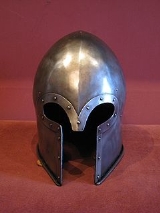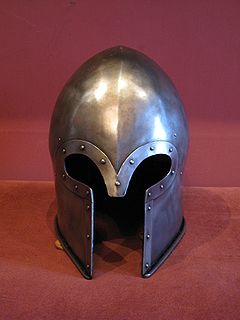
Barbute
Encyclopedia

Italian Renaissance
The Italian Renaissance began the opening phase of the Renaissance, a period of great cultural change and achievement in Europe that spanned the period from the end of the 13th century to about 1600, marking the transition between Medieval and Early Modern Europe...
design, often with distinctive "T" shaped or "Y" shaped opening for the eyes and mouth. The barbute resembles classical Greek
Classical Greece
Classical Greece was a 200 year period in Greek culture lasting from the 5th through 4th centuries BC. This classical period had a powerful influence on the Roman Empire and greatly influenced the foundation of Western civilizations. Much of modern Western politics, artistic thought, such as...
helmets and may have been influenced by a renewed interest in ancient artifacts.
The defining characteristic of the barbute is the fact that the shape of the helmet extends all the way down to cover both sides of the face. Regardless of the type of opening—which could be T-shaped, Y-shaped or arch-shaped, this characteristic is practically always present. This made the wearing of a gorget
Gorget
A gorget originally was a steel or leather collar designed to protect the throat. It was a feature of older types of armour and intended to protect against swords and other non-projectile weapons...
optional. On some examples, there is a central, narrow protrusion extending down from the top of the opening, designed to protect the wearer's nose. Often, barbutes were covered by fabric, most typically heavy velvet.
The main differences between the barbute and the Greek hoplite
Hoplite
A hoplite was a citizen-soldier of the Ancient Greek city-states. Hoplites were primarily armed as spearmen and fought in a phalanx formation. The word "hoplite" derives from "hoplon" , the type of the shield used by the soldiers, although, as a word, "hopla" could also denote weapons held or even...
's helm to which it is often compared are the difference in material (Ancient Greeks used bronze
Bronze
Bronze is a metal alloy consisting primarily of copper, usually with tin as the main additive. It is hard and brittle, and it was particularly significant in antiquity, so much so that the Bronze Age was named after the metal...
) and the lack of a prominent decorative crest.
Barbutes were made mostly from a single sheet of steel
Steel
Steel is an alloy that consists mostly of iron and has a carbon content between 0.2% and 2.1% by weight, depending on the grade. Carbon is the most common alloying material for iron, but various other alloying elements are used, such as manganese, chromium, vanadium, and tungsten...
using the metal smithing process of raising
Raising
Raising may refer to:*Raising , a syntactic construction*Raising , a change in a vowel towards a closer articulation*Raising , a metalworking technique...
until the piece assumed the desired shape. Often a low ridged crest was forged into the top of the helmet's skull which served to strengthen the helmet without adding a significant amount of weight.

